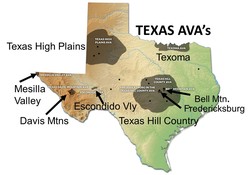AVA On The Label – What Does it Mean? (Jan-2022 TX AVA #2)
 Following the most recent Carl’s Corner that introduced Texas AVAs, you may wonder what is the point for having such territorial designations. An AVA designation on a wine label allows vintners to more accurately describe to consumers the origin of the grapes used to produce their wines and help consumers identify wines with characteristics they prefer to purchase. This involves a relatively complicated set of guidelines from the Alcohol and Tobacco, Tax and Trade Bureau (TTB) under 27 CFR 4.25, some of which are summarized below.
Following the most recent Carl’s Corner that introduced Texas AVAs, you may wonder what is the point for having such territorial designations. An AVA designation on a wine label allows vintners to more accurately describe to consumers the origin of the grapes used to produce their wines and help consumers identify wines with characteristics they prefer to purchase. This involves a relatively complicated set of guidelines from the Alcohol and Tobacco, Tax and Trade Bureau (TTB) under 27 CFR 4.25, some of which are summarized below.
First of all, wine consumers are becoming more curious about the origin of grapes used to produce the wines they enjoy. In the broadest sense, grapes can come from anywhere – another country, anywhere else in the U. S. (another state), anyplace in Texas, or from a more carefully defined area or region in Texas. Does it matter? – Sure it does, especially to the grape grower and winemaker! And, it is beginning to matter more to consumers.
To set the stage, let’s consider two examples from other wine regions. A wine from France could carry the broad appellation of France, meaning grapes from anywhere in the country, a narrower appellation like Bordeaux, a large, famous wine region in northwestern France, or Saint-Julien, a specific area in Bordeaux around the village of Saint-Julien where very high quality grapes are grown. A U.S. example would be the designation of California on the label indicating the grapes came from somewhere in that state. A narrower label designation of Napa Valley AVA indicates the grapes were grown in that famous region north of San Francisco. Further, a designation of Rutherford Bench indicates the grapes were grown in a specified area (a Napa Valley sub-AVA) around the town of Rutherford near the center of Napa Valley where some of the highest quality vineyards are located.
Translating this to Texas relates to grapes grown anywhere in the state, in one of the eight specified AVAs (see the map below), or outside a designated AVA. From time to time, Texas vintners have purchased grapes from other parts of the U.S., especially California, and those wines should carry the label designation American. If a required percentage of the grapes come from Texas, but not specifically from a defined AVA, the wine can carry the label designation Texas. If at least 85% of the grapes come from a Texas AVA, then the wine can carry the label designation of that AVA, such as Texas Hill Country or Texas High Plains. You are probably beginning to get the picture here that the TTB guidelines allow a narrowing of the grape source designation based on the AVA system.
This narrowing concept follows these TTB rules, although some states have opted for selective tightening of the requirements.
Source - Min. % of Grapes
Appellation Label Designation from the Appellation
Country American 75%
State Texas 75% (100% for CA and OR)
County County Name 75%
AVA AVA Name 85% (95% for OR)
Vineyard Specific Vyd Name 95%
As the Texas wine industry evolves, it is important to market the specific appellations and micro-climates as distinct growing regions with different characteristics. After all, Texas is a big state and connecting wineries and wines with the defining characteristics of an appellation will enhance the drinking experience by providing consumers with that “sense of place.” There have been recent efforts to tighten some of these requirements in Texas, and that subject will be addressed in the future. In the meantime, sit back, enjoy some fine Texas wines, and embark on this educational adventure to define and understand Texas AVAs.
